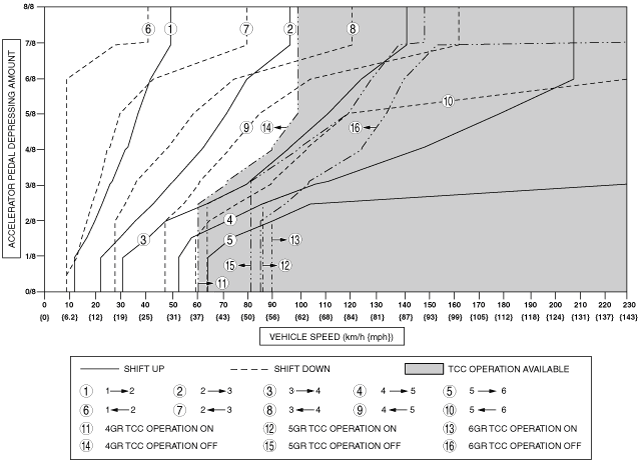 |
ROAD TEST [AY6A-EL, AY6AX-EL]
id0517k3297000
Road Test Preparation
1. Inspect the engine coolant. (See ENGINE COOLANT LEVEL INSPECTION [MZI-3.7].)
2. Inspect the engine oil. (See ENGINE OIL LEVEL INSPECTION [MZI-3.7].)
3. Inspect the ATF. (See AUTOMATIC TRANSAXLE FLUID (ATF) INSPECTION [AY6A-EL, AY6AX-EL].)
4. Inspect the idle speed. (See ENGINE TUNE-UP [MZI-3.7].)
5. Inspect the ignition timing. (See ENGINE TUNE-UP [MZI-3.7].)
6. Verify that no DTCs recorded. (See ON-BOARD DIAGNOSTIC SYSTEM DTC INSPECTION [AY6A-EL, AY6AX-EL].)
Shift Diagram (Normal Mode at D Position)
ac9uuw00003905
|
D Position Test
1. Perform the “Road Test Preparation”. (See Road Test Preparation.)
2. Warm up the transaxle.
3. Shift the D position.
4. Inspect the shift point for the D position in normal mode.
Shift point
|
Position/Mode |
Accelerator pedal depressing amount |
Shift |
Vehicle speed (km/h {mph}) |
Turbine speed (rpm) |
|
|---|---|---|---|---|---|
|
D
|
NORMAL
|
8/8
|
D1→D2
|
49—55 {31—34}
|
5,250—5,850
|
|
D2→D3
|
95—103 {59—63}
|
5,800—6,250
|
|||
|
D3→D4
|
140—150 {87—93}
|
5,600—5,950
|
|||
|
TCC ON (D4)
|
140—150 {87—93}
|
4,150—4,400
|
|||
|
D4→D5
|
206—216 {128—133}
|
6,150—6,350
|
|||
|
TCC ON (D5)
|
206—216 {128—133}
|
4,550—4,750
|
|||
|
D5→D6
|
227—237 {141—146}
|
5,050—5,200
|
|||
|
TCC ON (D6)
|
227—237 {141—146}
|
4,000—4,150
|
|||
|
4/8
|
D1→D2
|
28—35 {18—21}
|
2,900—3,800
|
||
|
D2→D3
|
53—69 {33—42}
|
3,200—4,200
|
|||
|
D3→D4
|
83—109 {52—67}
|
3,350—4,350
|
|||
|
TCC ON (D4)
|
83—109 {52—67}
|
2,500—3,200
|
|||
|
D4→D5
|
126—161 {79—99}
|
3,750—4,750
|
|||
|
TCC ON (D5)
|
126—161 {79—99}
|
2,800—3,550
|
|||
|
D5→D6
|
221—239 {138—148}
|
4,900—5,250
|
|||
|
TCC ON (D6)
|
221—239 {138—148}
|
3,900—4,200
|
|||
|
0/8
|
D6→D5
|
57—62 {36—38}
|
1,000—1,100
|
||
|
D5→D4
|
45—50 {28—31}
|
1,000—1,100
|
|||
|
D4→D3
|
25—31 {16—19}
|
750—900
|
|||
|
D3→D2
|
6—12 {4—7}
|
250—450
|
|||
|
D2→D1
|
6—12 {4—7}
|
400—700
|
|||
|
D3→D1
|
6—12 {4—7}
|
250—450
|
|||
|
Kickdown (8/8)
|
D6→D5
|
225—235 {140—145}
|
4,000—4,100
|
||
|
D5→D4
|
159—168 {99—104}
|
3,500—3,700
|
|||
|
D4→D3
|
117—126 {73—78}
|
3,500—3,700
|
|||
|
D3→D2
|
76—84 {48—52}
|
3,050—3,350
|
|||
|
D2→D1
|
38—44 {24—27}
|
2,350—2,650
|
|||
|
D
|
AAS
|
8/8
|
D1→D2
|
49—55 {31—34}
|
5,250—5,850
|
|
D2→D3
|
95—103 {59—63}
|
5,800—6,250
|
|||
|
D3→D4
|
140—150 {87—93}
|
5,600—5,950
|
|||
|
D4→D5
|
206—216 {128—133}
|
6,150—6,350
|
|||
|
D5→D6
|
227—237 {141—146}
|
5,050—5,200
|
|||
|
4/8
|
D1→D2
|
28—35 {18—21}
|
2,900—3,800
|
||
|
D2→D3
|
53—69 {33—42}
|
3,200—4,200
|
|||
|
D3→D4
|
83—109 {52—67}
|
3,350—4,350
|
|||
|
D4→D5
|
143—172 {89—106}
|
4,250—5,050
|
|||
|
D5→D6
|
201—226 {125—140}
|
4,450—4,950
|
|||
|
0/8
|
D6→D5
|
107—113 {67—70}
|
1,900—1,950
|
||
|
D5→D4
|
65—71 {41—44}
|
1,450—1,550
|
|||
|
D4→D3
|
27—33 {17—20}
|
800—950
|
|||
|
D3→D2
|
6—12 {4—7}
|
250—450
|
|||
|
D2→D1
|
6—12 {4—7}
|
400—700
|
|||
|
D3→D1
|
6—12 {4—7}
|
250—450
|
|||
|
Kickdown (8/8)
|
D6→D5
|
225—235 {140—145}
|
4,000—4,100
|
||
|
D5→D4
|
180—190 {112—117}
|
4,000—4,150
|
|||
|
D4→D3
|
125—135 {78—83}
|
3,750—3,950
|
|||
|
D3→D2
|
76—84 {48—52}
|
3,050—3,350
|
|||
|
D2→D1
|
38—44 {24—27}
|
2,350—2,650
|
|||
M Position Test
1. Perform the “Road Test Preparation”. (See Road Test Preparation.)
2. Warm up the transaxle.
3. Shift the M position.
4. Inspect the shift point for the M position.
Shift point
|
Position/mode |
Accelerator pedal depressing amount |
Shift |
Vehicle speed (km/h {mph}) |
Turbine rotation speed (rpm) |
|
|---|---|---|---|---|---|
|
M
|
8/8
|
TCC ON (M6)
|
227―237 {141―146}
|
4,000―4,150
|
|
|
4/8
|
TCC ON (M6)
|
201―226 {125―140}
|
3,550―3,950
|
||
|
0/8
|
M6→M5
|
44―50 {28―31}
|
800―850
|
||
|
M5→M4
|
34―40 {22―24}
|
750―850
|
|||
|
M4→M3
|
23―29 {15―17}
|
700―850
|
|||
|
M3→M2
|
4―10 {3―6}
|
200―350
|
|||
|
M2→M1
|
4―10 {3―6}
|
250―600
|
|||
|
M3→M1
|
4―10 {3―6}
|
200―350
|
|||
5. Inspect 2GR fixed mode.
P Position Test
1. Shift the selector lever to P position on a gentle slope.
2. Release the brake and verify that the vehicle does not roll.